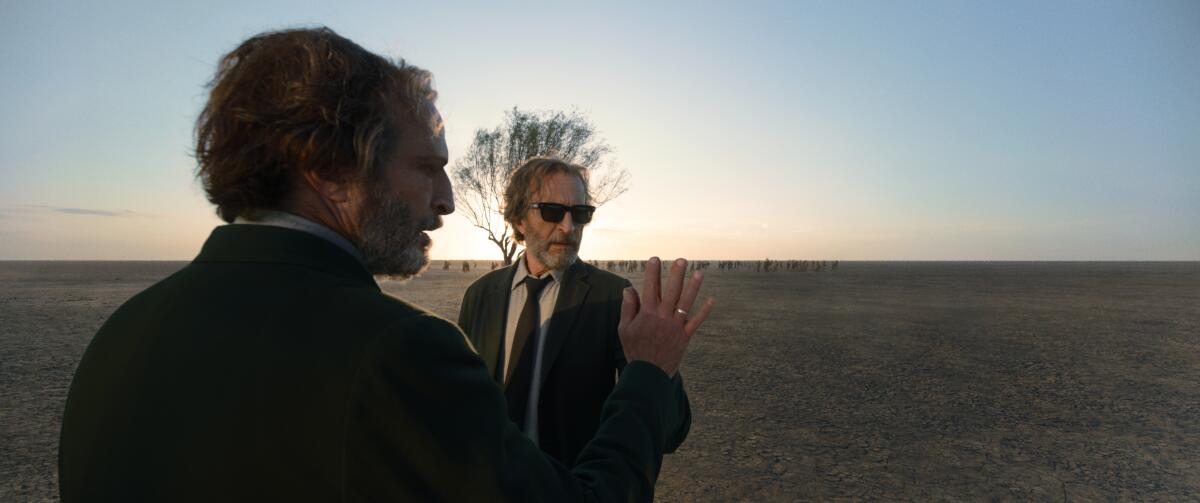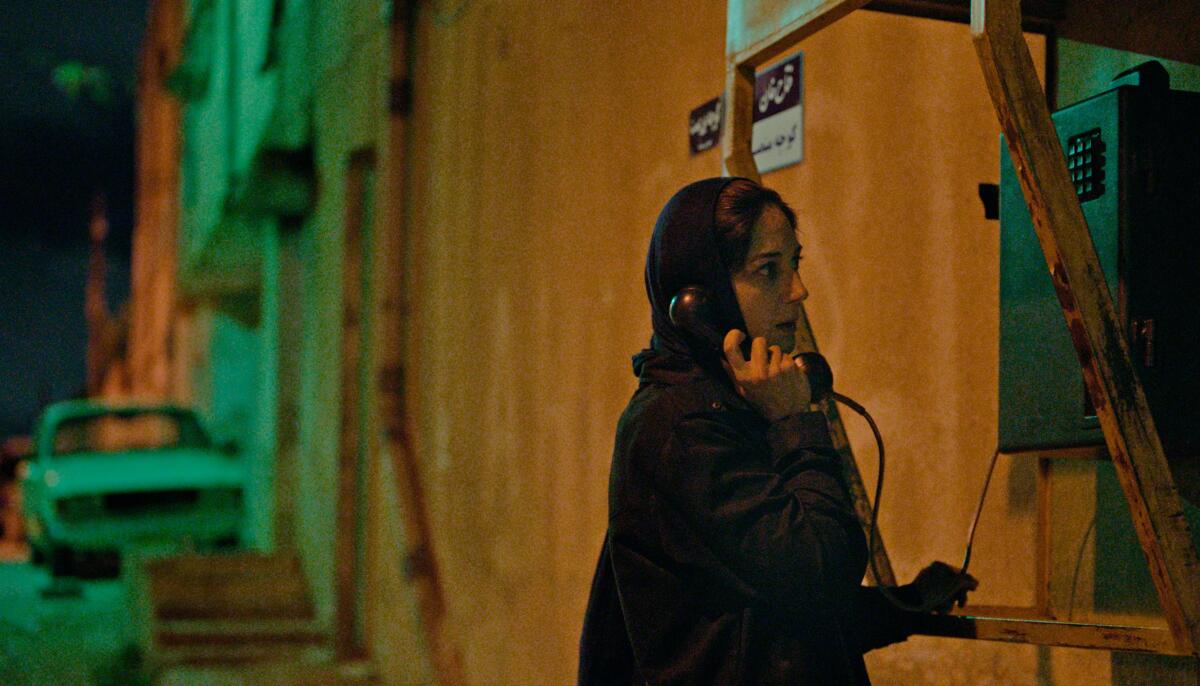Indulgent or inspired? ‘Bardo’ divides critics

- Share via
Hello! I’m Mark Olsen. Welcome to another edition of your regular field guide to a world of Only Good Movies.
Only good movies
Get the Indie Focus newsletter, Mark Olsen's weekly guide to the world of cinema.
You may occasionally receive promotional content from the Los Angeles Times.
This is a week where there are more worthwhile new movies than can fit into the format of this newsletter. Among other new releases are Luca Guadagnino’s “Salvatore: Shoemaker of Dreams,” Sebastián Lelio’s “The Wonder,” Ryan White’s “Good Night Oppy,” Will Lovelace and Dylan Southern’s “Meet Me in the Bathroom” and Eric Appel’s “Weird: The Al Yankovic Story.”
AFI Fest rolls on. The film festival is already underway, but there are still plenty of great films to see, including “One Fine Morning,” with filmmaker Mia Hansen-Løve and actor Léa Seydoux in attendance, and the local premieres of Steven Spielberg’s “The Fabelmans,” Luca Guadagnino’s “Bones and All,” Sarah Polley’s “Women Talking” and Maria Schrader’s “She Said.”
Justin Chang wrote up his own list of suggestions for the festival, and even if you miss the AFI Fest screenings of these titles, it makes for a handy guide for future reference, with films such as Nikyatu Jusu’s “Nanny,” Jafar Panahi’s “No Bears” and Alice Diop’s “Saint Omer.”
Gina Prince-Bythewood tribute. The American Cinematheque is putting on a tribute to filmmaker Gina Prince-Bythewood this weekend, with screenings of “Love & Basketball,” “Beyond the Lights” and a double bill of her recent “The Woman King” with “The Old Guard.” The screening of “The Old Guard” marks the first public theatrical showing of the 2020 action film, which was released to Netflix during the early days of the pandemic. I will be moderating a conversation with Prince-Bythewood on Saturday between films.
“Bad Axe” screening. As part of the Indie Focus Screening Series, we are very excited to present David Siev’s documentary “Bad Axe,” which premiered earlier this year at the South by Southwest Film & TV Festival. The film is an intimate portrait of Siev’s own family as they grapple with the crises of 2020 amid rising tensions in their small Michigan community. The filmmaker and some of his subjects (including his parents!) will be there for a Q&A after the movie on Monday night.
New newsletter. If you’re reading this newsletter, it is presumably because you like to keep up with what’s going on. So you’ll also want to sign up for The Times’ newest newsletter, L.A. Goes Out. It’s a weekly curated look at the most exciting local events, and it launches Nov. 16. Sign up here.
Enjoying this newsletter? Consider subscribing to the Los Angeles Times
Your support helps us deliver the news that matters most. Become a subscriber.
‘Bardo, False Chronicle of a Handful of Truths’
Directed and co-written by Alejandro G. Iñárritu, “Bardo, False Chronicle of a Handful of Truths” finds the Oscar winner shooting in his native Mexico for the first time in more than 20 years, turning in a magical-realist fantasy about an acclaimed journalist and filmmaker, Silverio Gama (Daniel Giménez Cacho), attempting to make sense of his life. The film is Mexico’s submission for the international feature Oscar and is in theaters now and streaming on Netflix Dec. 16.
For The Times, Justin Chang wrote about the film and its self-reflective nature when it played at the Telluride Film Festival, saying, “These are not uninteresting questions, but Iñárritu, rather than answering them or leaving them provocatively unanswered (either one would be fine), does what he seems to do with most of his stories and ideas nowadays: He flings them around, roughs them up and rearranges them into an imposing, finally insufferable monument to his own awesomeness.”
For the New York Times, A.O. Scott wrote, “Silverio is so determined to defend himself that it may be superfluous to defend ‘Bardo,’ which is proudly and self-evidently the product of a monumental ego. It is also, however, the work of a prodigious and unruly talent. Iñárritu isn’t always the clearest or most cogent thinker, but the power of his images often renders such objections moot. ‘Bardo,’ shot in wide-screen 65 millimeter through lenses that seem to warp the edges of the frame, is full of arresting, hallucinatory sequences that linger in the mind long after Silverio’s self-pitying harangues have faded. … The man at the center of it all — we’ll keep calling him Silverio, for the sake of consistency — can be exasperating, exhausting company. He is also charming, funny and unmistakably sincere, and you can’t help but hope that he finds some peace.”
For the Wrap, Carlos Aguilar wrote, “If one thematic throughline is evident in Iñárritu’s latest, it’s his belief that we construct ourselves from stories that are partially or entirely untrue, but that we nonetheless believe in order to function within the boundaries of our powerlessness. As spectacularly contradictory as the country of Mexico itself, ‘Bardo’ revels in the sharp self-deprecation of its seriousness. … Made adventurously with no reservations, ‘Bardo’ seems like the realized goal of an artist who would be fine with this being the final chapter in his filmography.”
At Entertainment Weekly, Leah Greenblatt wrote, “The heights of self-regard here feel like both a feature and a bug, an earnest dispatch from a febrile and wildly fertile mind that doesn’t always distinguish between artistry and uncut narcissism. … As an all-in-one viewing experience, ‘Bardo’ is undeniably uneven, often maddening, and seems to have approximately 17 endings. Still, the movie is a marvel in its own way, dotted with pure cinephile delights and small unexpected pockets of profundity: a flawed but frequently dazzling monument to big-swing filmmaking in an era of relentlessly bland franchises and IP, as bold and strange and somehow true to life, in the end, as anything.”
For Vanity Fair, Richard Lawson wrote, “Iñárritu has a lot on his mind here, weighing the sins and graces of personal and public history, and attempting to atone for some of it. But as ‘Bardo’ stretches on and on and on, the film narrows into something solipsistic and meta. … This has long been a problem of the director’s: His work is often technically marvelous but emotionally, spiritually, philosophically inert. Meaning gets swallowed up by ultra-high style; what’s left when all the adornment is pared away is a director indicating toward his own prowess. ‘Bardo’ is the most glaring example of that tendency yet, self-obsessed and self-glorifying well beyond what’s tolerable. I suppose we do learn a great deal about where Iñárritu’s head has been these past few years, but the value of that insight is vastly disproportionate to the ornate contraption housing it. ‘Bardo’ isn’t really a thinly veiled memoir; it’s a love letter.”

Enjoying this newsletter? Consider subscribing to the Los Angeles Times
Your support helps us deliver the news that matters most. Become a subscriber.
‘Holy Spider’
Directed and co-written by Ali Abbasi, “Holy Spider” is based on the true-crime story of a serial killer in the Iranian city of Mashhad. In the film, as the killer, Saeed (Mehdi Bajestani), believes himself to be cleansing the city of immoral women, the case is pursued by a female investigative journalist, Rahimi (Zar Amir Ebrahimi). The film is Denmark’s submission for the international feature Oscar and is in theaters now.
For The Times, Justin Chang wrote, “The moral incoherence of ‘Holy Spider’ arises precisely from those [art-house] pretensions, which the movie ultimately can’t reconcile with its garden-variety bloodlust. … The story does build, in its second act, to an unsettlingly persuasive indictment of a society that teaches even its youngest members to hate, condemn and destroy women. But did the movie have to fixate so lovingly on that destruction, or make its chief destroyer so compelling? Bajestani, a convincing Everyman with a charismatic glower, expertly suggests the monster — and the petulant man-child — seething inside the loving, prayerful family man. It’s hardly the actor’s fault that Saeed’s perspective should finally overwhelm all others, or that ‘Holy Spider’ should become the latest high-minded exploitation flick to wring its hands along with its characters’ necks.”
For the New York Times, Devika Girish wrote, “The irony at the heart of ‘Holy Spider’ is fascinating and timely: How does a holy city not just foster but actively embolden prostitution, a drug trade and reckless slaughter? The film’s genre-movie stylings, however, flatten these sociopolitical questions into psychosexual spectacles. Abbasi seems enamored by the contradictions of Hanaei, who was at once an upstanding Muslim, a family man, a pervert and a ruthless killer. But anyone who reads the news, anywhere in the world, will respond to these rote hypocrisies of misogyny with little other than jadedness.”
For Vulture, Alison Willmore wrote, “‘Holy Spider’ is true crime in the guise of an art-house film, which makes it unusually squirrelly in its attempts to be about something more while also delivering lurid spectacle. It nevertheless gets to the goods pretty quickly, showing woman after woman being picked up from the streets of the Iranian city of Mashhad, brought back to the killer’s apartment, and then strangled to death by hand or with their own headscarf. … [It was] filmed in Jordan with the added liberties that allows, including a lead actor — Zar Amir Ebrahimi — who fled Iran in 2008 and a framing that explicitly links the murders to societal and religious misogyny. As a concept, it’s urgent and timely, but the execution is so muddled that the movie feels entirely defanged.”

‘Something in the Dirt’
Directed by Justin Benson and Aaron Moorhead, “Something in the Dirt” stars the filmmakers in a sci-fi thriller that attempts to capture the paranoia and bad vibes of the pandemic era. When Levi (Benson) moves into a new apartment, he strikes up a relationship with his neighbor John (Moorhead), and the two spiral into a world of conspiracy theories as they try to unravel the strange phenomenon happening around them. The film is in theaters now.
For The Times, Noel Murray wrote, “Benson and Moorhead can’t sustain the relaxed hangout vibe of ‘Something in the Dirt’ all the way to the end. When they have to start resolving their minimal plot — by explaining what happened to these guys, and offering firmer explanations for all the strange sounds and floaty things — the movie comes back down to earth a bit. But for the first 90 minutes or so, there’s remarkable vibrancy and spontaneity to this picture, as its creators and stars seem to be coming up with their story on the spot, with the cameras rolling. They seem inspired and excited. The mood is infectious.”
For the New York Times, Jeannette Catsoulis wrote, “‘Something in the Dirt’ is one of those weird little surprises sometimes found skulking in the crannies of mainstream film festivals, slippery and screwy and impossible to categorize. An ambitious potluck of buddy comedy, paranormal puzzle and whatdunnit mystery, this fifth feature from the filmmaking team of Justin Benson and Aaron Moorhead cheerfully substitutes audacity for discipline. … Overlong and overwritten, ‘Dirt’ nevertheless unfolds with an enjoyably comic quirkiness, a tale of two doofuses who sought meaning in symbols and found comfort in friendship.”
For io9, Germain Lussier wrote, “So basically we’re watching a film about people making a film, but also the film we’re watching is their finished film. Which can be a little confusing at times, almost by design. [John] and Levi’s storyline starts at the beginning but is quickly crosscut with talking head experts, including [John] and Levi themselves, speaking about it in retrospect, adding multiple layers of intrigue and suspense on top of what’s happening. … The movie has so many threads to pick at you get the sense no single reading of the film is right or wrong. Benson and Moorhead have created a film with so many breadcrumbs, each viewer can surely make it their own.”

Only good movies
Get the Indie Focus newsletter, Mark Olsen's weekly guide to the world of cinema.
You may occasionally receive promotional content from the Los Angeles Times.




